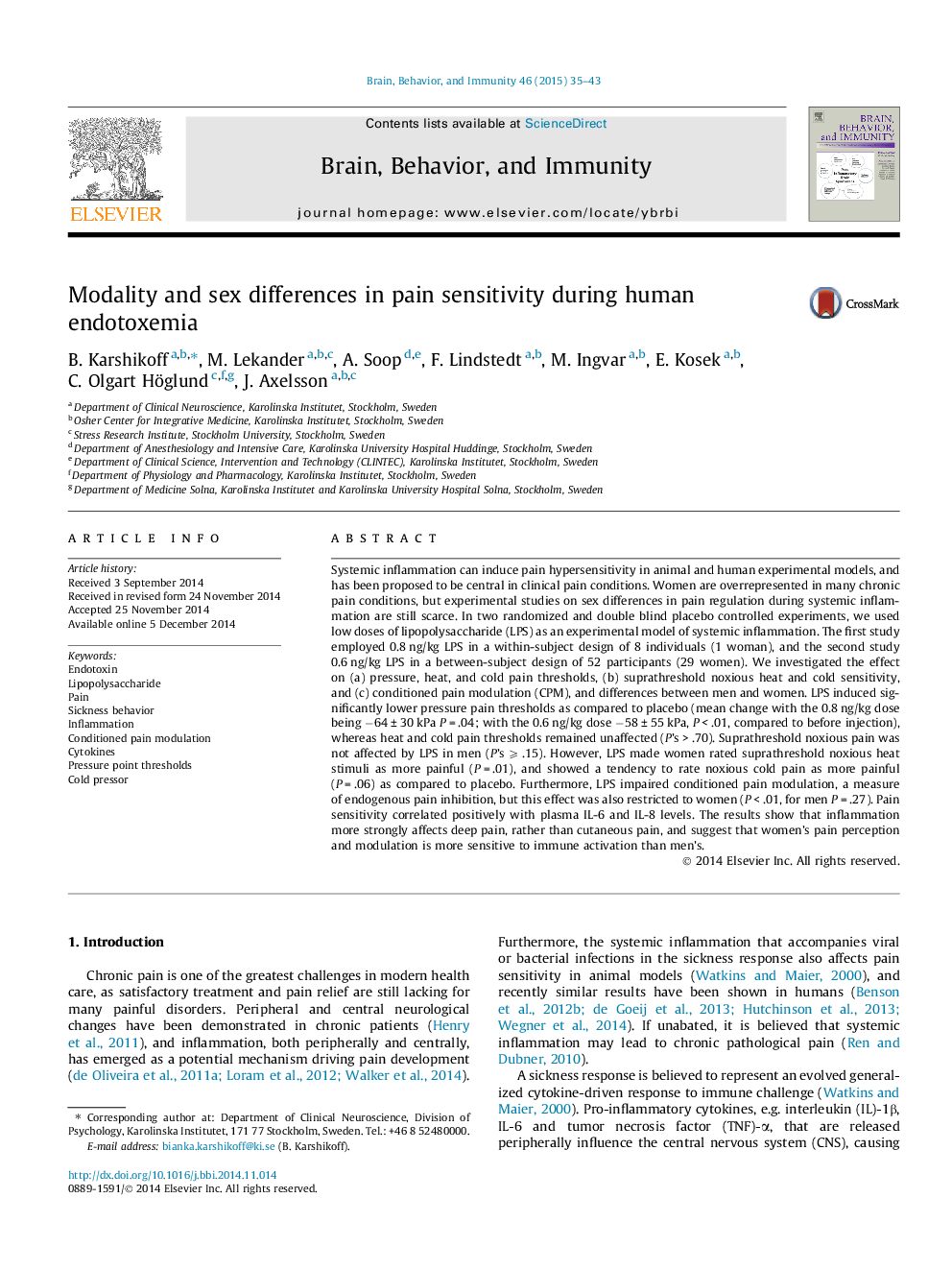| کد مقاله | کد نشریه | سال انتشار | مقاله انگلیسی | نسخه تمام متن |
|---|---|---|---|---|
| 7281026 | 1473921 | 2015 | 9 صفحه PDF | دانلود رایگان |
عنوان انگلیسی مقاله ISI
Modality and sex differences in pain sensitivity during human endotoxemia
ترجمه فارسی عنوان
اختلالات رفتاری و جنسی در حساسیت درد در طی اندوتوکسمی انسانی
دانلود مقاله + سفارش ترجمه
دانلود مقاله ISI انگلیسی
رایگان برای ایرانیان
کلمات کلیدی
اندوتوکسین، لیپوپلی ساکارید، درد، رفتار بیمار، التهاب مدولاسیون درد مداوم، سیتوکین ها، آستانه نقطه فشار، فشارسنج سرد
موضوعات مرتبط
علوم زیستی و بیوفناوری
ایمنی شناسی و میکروب شناسی
ایمونولوژی
چکیده انگلیسی
Systemic inflammation can induce pain hypersensitivity in animal and human experimental models, and has been proposed to be central in clinical pain conditions. Women are overrepresented in many chronic pain conditions, but experimental studies on sex differences in pain regulation during systemic inflammation are still scarce. In two randomized and double blind placebo controlled experiments, we used low doses of lipopolysaccharide (LPS) as an experimental model of systemic inflammation. The first study employed 0.8 ng/kg LPS in a within-subject design of 8 individuals (1 woman), and the second study 0.6 ng/kg LPS in a between-subject design of 52 participants (29 women). We investigated the effect on (a) pressure, heat, and cold pain thresholds, (b) suprathreshold noxious heat and cold sensitivity, and (c) conditioned pain modulation (CPM), and differences between men and women. LPS induced significantly lower pressure pain thresholds as compared to placebo (mean change with the 0.8 ng/kg dose being â64 ± 30 kPa P = .04; with the 0.6 ng/kg dose â58 ± 55 kPa, P < .01, compared to before injection), whereas heat and cold pain thresholds remained unaffected (P's > .70). Suprathreshold noxious pain was not affected by LPS in men (P's ⩾ .15). However, LPS made women rated suprathreshold noxious heat stimuli as more painful (P = .01), and showed a tendency to rate noxious cold pain as more painful (P = .06) as compared to placebo. Furthermore, LPS impaired conditioned pain modulation, a measure of endogenous pain inhibition, but this effect was also restricted to women (P < .01, for men P = .27). Pain sensitivity correlated positively with plasma IL-6 and IL-8 levels. The results show that inflammation more strongly affects deep pain, rather than cutaneous pain, and suggest that women's pain perception and modulation is more sensitive to immune activation than men's.
ناشر
Database: Elsevier - ScienceDirect (ساینس دایرکت)
Journal: Brain, Behavior, and Immunity - Volume 46, May 2015, Pages 35-43
Journal: Brain, Behavior, and Immunity - Volume 46, May 2015, Pages 35-43
نویسندگان
B. Karshikoff, M. Lekander, A. Soop, F. Lindstedt, M. Ingvar, E. Kosek, C. Olgart Höglund, J. Axelsson,
